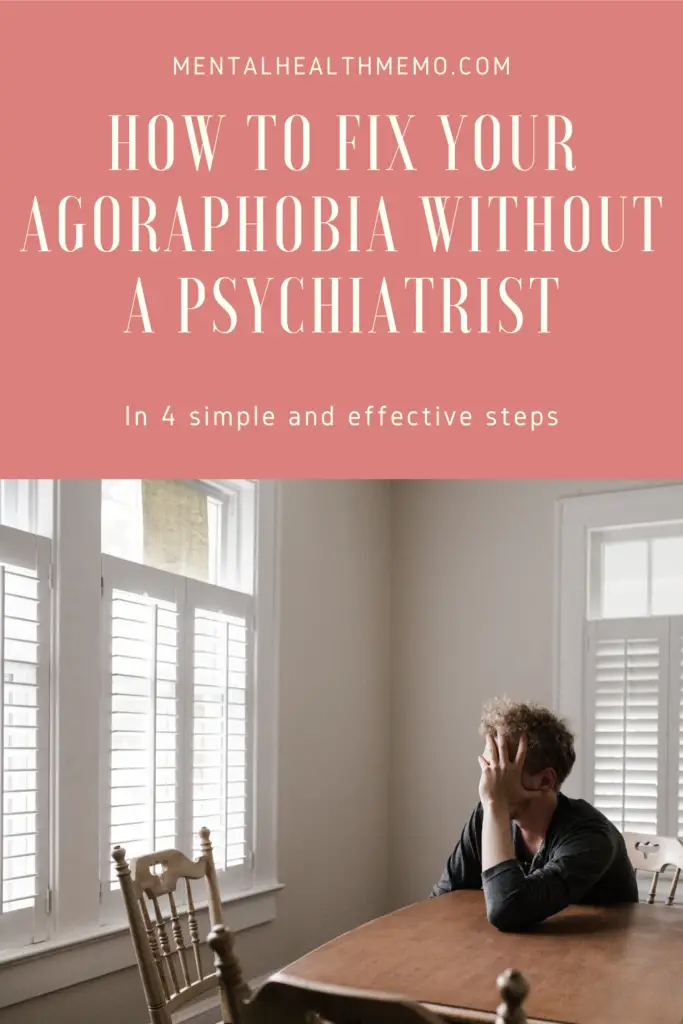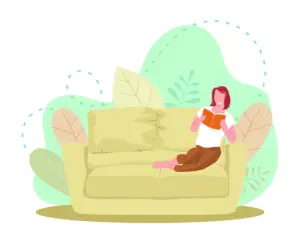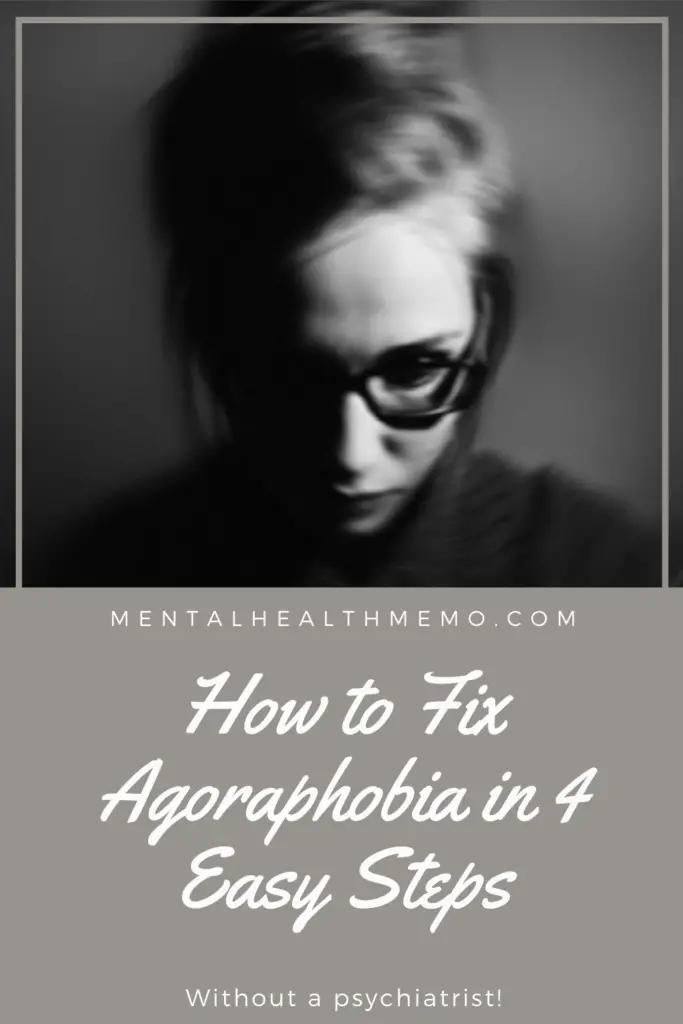Welcome to another post!
This week we’re going to be discussing how to fix your Agoraphobia without a psychiatrist through utilizing Exposure Therapy in 4 simple steps!
I wanted to write this post because as some of you may or may not know from my journey with anxiety post, I have both Panic Disorder and Agoraphobia and they greatly impacted my life when I was around 13.
It got so bad that I couldn’t go to school, ride the bus, or even go for a walk around my neighborhood without getting a panic attack. Because of that, I had to reach out and get professional help.
I’m extremely lucky to have had access to an amazing psychiatrist who could walk with me through the steps to get better and be able to live my life relatively normal again.
I’m now able to work, attend school, drive a car, go on trips and so much more with a lot more ease and comfort.
However, I know many people do not have the ability to see a professional but are still greatly suffering from Agoraphobia.
So in this post, I’m going to go over what you can do to fix your Agoraphobia without a psychiatrist and start thriving again.
Obviously, if you can get access to a mental health professional instead of using this post it would be the best option. But, if that’s not possible, this post and your hard work will do.
Disclaimer: I am not a licensed mental health professional. I am a Social Work and Psychology student, who has gone through exposure therapy. So I am pulling from my studies of mental abnormalities, my experience, and my worksheets from therapy to formulate this post. I do not replace a doctor, psychiatrist, or any other medical professional.

Table of Contents
What is Agoraphobia?
For those that aren’t familiar with Agoraphobia, it is phobia characterized by an extreme fear of situations in which one cannot escape from. These situations are anxiety-inducing for individuals with Agoraphobia as they are scared they’ll have a panic attack or anxious feelings and not be able to leave or find help.
This often leads to severe isolation and avoidance which is why when people hear Agoraphobia they often think of someone that can’t leave their house or that has a hard time in a crowd.
This is a serious anxiety disorder that can be incredibly debilitating and cause severe issues in a person’s life.
And while Agoraphobia can be a stand-alone mental illness, it more often goes hand in hand with Panic Disorder. Panic Disorder is a mental illness categorized by repeated and often unexpected or out-of-the-blue panic attacks.
The Secret to How to Fix Your Agoraphobia: Exposure Therapy
What did I do with my psychiatrist that created such a big shift in my life? Exposure therapy. Exposure Therapy is a type of therapy used to treat phobias and certain anxiety disorders such as OCD.
The objective of the therapy is to have you repeatedly do the things that cause you anxiety in varying levels of severity while practicing coping skills. This is in an effort to neutralize you to the situation so that you don’t get as anxious anymore.
For example, let’s say Timmy has a phobia of dogs. We start off by showing Timmy pictures of dogs. As he’s looking at the picture, he’s also practicing calming coping techniques. Once Timmy is no longer scared of looking at pictures of dogs, we can move on to something like watching videos of dogs.
We continue to up the level of severity while Timmy practices his coping skills until he can finally pet a dog with zero to minimal anxiety.
So this is how exposure therapy ideally works. You follow the same formula for anxiety disorders too.
The reason exposure therapy is so effective is you do the things that cause you anxiety but also practice coping skills at the same time.
It also makes you go against the flawed logic of your anxious brain. What I mean by that is in a panic-attack- inducing-situation your brain is saying “this is not safe, we can’t do this, and we need to leave”.
But by repeatedly exposing yourself to these anxiety-inducing situations and being okay in the end, you’re showing your brain that it’s wrong and that the situation isn’t scary. Ultimately making you no longer panicky in said situations.
1st Step: The Hierarchy
I want you to take out a piece of paper, or open up a Word document. Write the 10 things that are giving you the most anxiety. 1st being the least scary, 10th being the worst. In terms of Agoraphobia, these can be the places or situations that scare you the most.
I can provide an example based on my own list back when I did therapy with my psychiatrist.
- Thinking about the outside world
- Going for a walk in the neighborhood
- Going to a friend’s house
- Going to a mall
- Going to a restaurant
- Going in an elevator
- Going on public transport
- Going to school (the general building)
- Being inside the classroom
- Traveling
So obviously this is not going to be your list, but it’s just to offer an example. School and being far away from home have always been my biggest triggers which is why they were the highest-ranked.
In comparison, thinking about going outside was still anxiety-inducing, but severely less so.
Think about what places or situations you avoid because you think it’s likely you’ll have a panic attack. Those are the things you need to be writing down.
You don’t have to formulate your list right away. You can take your time and adjust things if your feelings about something have changed. But once you’re set, you can move onto the next step.

2nd Step: Marking Things Off
So now we start doing the things that give us anxiety.
You can start from #1 if you’re really struggling, but typically therapists will recommend starting from #3-#5. Of course, the fun part about doing it alone is you get to decide!
Wherever you start, you need to stay there until you feel little to no anxiety. The whole point of the hierarchy is that you build your ability to cope slowly by gradually doing things that are more anxiety-inducing until said things are no longer scary.
So for me, I had to go on a lottttttttttttt of elevators before I stopped being so anxious and could move onto scarier things like going to school. Of course, you may never fully erase the anxiety, but at least minimize it.
I still get slightly nervous when I get on elevators even to this day but I don’t start hyperventilating and sweating like I used to. So if 0 anxiety is impossible (which it often is), just aim for maximum minimization.
If you’ve decided where you’re starting, it’s now going to be time to learn coping techniques to help you get through the anxiety these situations will induce.
3rd Step: Coping Techniques
Coping strategies are essential for you to be able to reach that maximum minimization of anxiety we just talked about.
There are actually a lot of different ways you can cope, it depends a lot on what does and doesn’t work in calming you down. Here are some examples of common techniques recommended by mental health professionals:
- Breathing exercises (Example: breathe into your stomach for 5 seconds, hold your breath for 5 seconds, exhale slowly for 5 seconds)
- Grounding exercises (Example: 1 thing you can taste, smell, touch, hear, and see. These are helpful if you dissociate a lot)
- Pep talks either you give yourself or someone else gives you (Example: you’ve been anxious before and gotten through this. You can do it)
- Distractions (Examples: phone games, books, fidget toys, a conversation with someone. Hell, when I was trying to get back into the classroom I would bring Playdoh and make little people with it)
- Grounding objects (Example: something physical that comforts you like a teddy bear, a scarf, mittens, a hairpin, honestly anything that gives you calm and happy energy)
Obviously there are more types of coping strategies, but these are some of the most common ones you’ll see.
You can give all of them a try and see what it is that helps you the most. You may find some effective, none effective, or most of them effective.
But the more strategies you have under your belt, the better. The more prepared you are for a potential panic attack, the easier the process will be.

4th Step: Actually Doing the Thing that Scares You
The reason why having a mental health professional is so beneficial (aside from their expertise) is they can help push you and keep you on track. If you’re doing this on your own, you need to be doing that for yourself.
The whole experience is extremely difficult, I can’t sugarcoat it. But if you want to get better, it needs to happen.
So yes, you can read this article and write that list, but if you’re not actually doing the work and challenging yourself consistently, you won’t get better.
If you find it beneficial, ask a friend or loved one to help you. Having support from someone else makes the journey so much more bearable. But if you want to do it alone, that’s fine too. Aside from my psychiatrist, I worked on exposure therapy alone most of the time.
But to succeed on this journey, you really need to be pushing yourself into all these uncomfortable situations. And it’s going to suck. But you need to do it to get better.
You have to check off every item on that hierarchy list if you want to start feeling more in control of your Agoraphobia.
And yes, it’s a lot easier said than done. But I HAVE done it. I couldn’t even step outside of my house at one point. It was that bad. Which is why I know you can do it too. Utilize your coping strategies to face these situations and stand your ground. I believe in you.

Final Thoughts
Exposure therapy is a type of therapy that I can definitely vouch for. It significantly helped me get in control of my life again after my Agoraphobia and Panic Disorder blew up.
Whether you end up choosing to go see a mental health professional, or you want to work alone, I hope this article at the very least helped you better understand Exposure Therapy, Agoraphobia, and Panic Disorder.
If you choose to go ahead with it, I wish you the very best on your journey. If you ever need support, you can always reach out to me.
All my love,
T


Absolutely loved this post! A lot here to take in, all of it in a very good way! Need to re-read it actually! Thanks for sharing!!
Thank you so much for your kind words, I’m glad you enjoyed it!
I can’t afford to see a doctor. But I am home almost all the time. I think my grandma’s both had this as they got older. I think my mom has this to a lesser degree than I do. But she doesn’t get out much either. I don’t feel like I could ever be outside not in a car. But I am also afraid of being in a car unless one trusted person is driving…. I don’t have any friends. I tried to and it ended badly many times. I love my mom. The rest of my family are all very tough for me to be around. I dont fear that anything bad will happen to me. I fear that I will ruin someone’s day, or moment, or life. By seeing me or hearing me. Or that I might do something wrong like break something or walk too slow. And I just don’t want to ruin anyone’s time.
It’s interesting that you bring up that your grandmothers both had this as they got older. It seems very common for folks that are aging to start getting Agoraphobic symptoms.
It can be really hard when those around us are not helpful to our struggles, but I assure you the voice in your head saying you’re ruining peoples’ lives by being around them is not telling you the truth. I’m wishing you so much light, love, and strength on your journey of getting better! You can do it 🙂
Thank you so much this helped me a lot I’m struggling so much rn and if I did it then I can do it ♥️ God bless u
I’m so glad you found this helpful and I’m so proud of you for trying to work on it! Wishing you the very best of luck as you continue your journey to getting better 🙂
I struggle with this and I feel like things never gets easier. For example, I go for a walk everyday, and I don’t get better. Even hours before I go outside my door I struggle because I don’t want to.. Everyday is a nightmare and I don’t see progress. Never making it to the next step on my list..
I 1000% relate to the struggle you’re feeling right now. It’s very draining to be stuck in that kind of loop but if you keep exposing yourself to the things that give you anxiety, eventually your brain will realize these things aren’t as big of a threat anymore. It takes a long time so please be patient and gentle with yourself as you overcome this. I’m wishing you so much love and strength!
Thank you so much, I will keep trying. Keep spreading awareness and helping people. You are awesome =)
Thank you so so much. Always feel free to reach out if you need!! 🙂 <3
I appreciate your recommendation of these blogs because I am always searching for Agoraphobia blogs. I have also learned lot of new things. Definitely I will share with others.